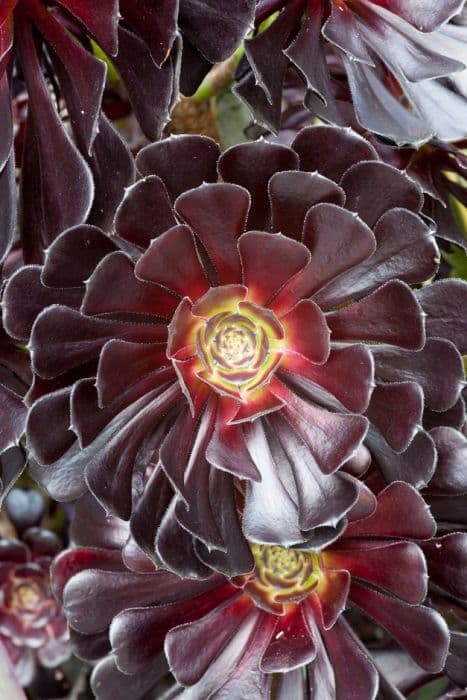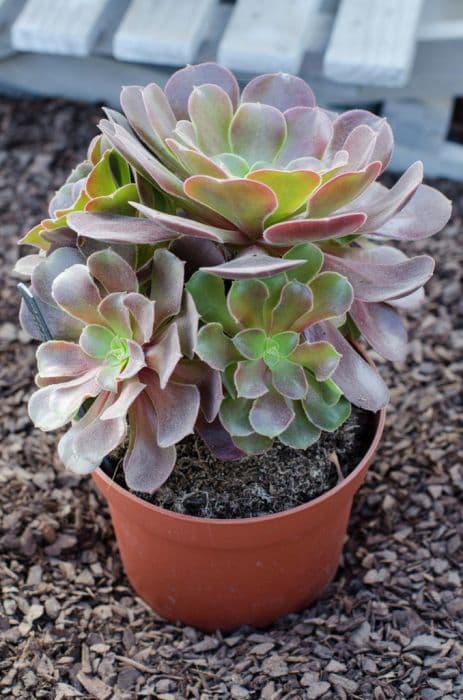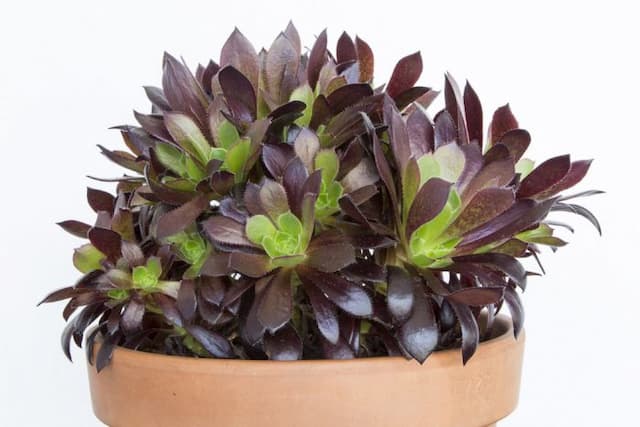Autumn Joy Hylotelephium Herbstfreude Group

ABOUT
The Hylotelephium Herbstfreude Group, commonly known as Autumn Joy, is a succulent perennial favored for its distinctive appearance and hardiness. The plant boasts a robust and upright habit, featuring fleshy, spoon-shaped leaves that are arranged in a whorl around its thick, sturdy stems. These leaves often have a glaucous, blue-green hue, which gives the plant a frosted appearance. During the blooming season, Autumn Joy produces large, flat-topped clusters of tiny, star-shaped flowers. The flowers start off a light, pastel pink and gradually deepen to a rich, coppery red as they mature through the season. The dense flower clusters offer a long-lasting display that attracts bees and butterflies, making it a popular choice for pollinator gardens. The succulent nature of its leaves allows Autumn Joy to be particularly drought tolerant, while the plant's rugged constitution helps it withstand various climatic conditions. The textural contrast between its leaves and flowers provides a visual interest that makes this plant a beloved feature of the fall garden landscape, offering color and form when many other plants begin to fade.
About this plant
 Names
NamesFamily
Crassulaceae
Synonyms
Autumn Joy, Stonecrop, Herbstfreude
Common names
Sedum spectabile 'Herbstfreude', Sedum 'Herbstfreude'.
 Toxicity
ToxicityTo humans
Autumn Joy sedum, also known as the Hylotelephium Herbstfreude Group, is generally considered to be non-toxic to humans. Therefore, it is not commonly associated with serious poisoning symptoms upon ingestion. However, as with any plant material, individual sensitivities can vary, and it may cause mild gastrointestinal upset or skin irritation in some people upon contact or ingestion.
To pets
Autumn Joy sedum, the common name for the Hylotelephium Herbstfreude Group, is generally not toxic to pets. It does not contain any known toxins that would be harmful to cats or dogs if they were to ingest it. However, consumption of plant material can sometimes lead to gastrointestinal upset in pets, such as vomiting or diarrhea, particularly if they consume large quantities. It's always a good idea to monitor your pets and prevent them from eating plants in general, to avoid any potential issues.
 Characteristics
CharacteristicsLife cycle
Perennials
Foliage type
Deciduous
Color of leaves
Green
Flower color
Pink
Height
1-2 feet (30-60 cm)
Spread
1-2 feet (30-60 cm)
Plant type
Succulent
Hardiness zones
3-9
Native area
Asia
Benefits
 General Benefits
General Benefits- Attracts Pollinators: The plant is known to attract bees and butterflies, supporting local ecosystems.
- Drought Tolerant: Once established, it requires minimal water, making it suitable for xeriscaped gardens.
- Easy Maintenance: It is low maintenance, not requiring frequent care or grooming.
- Seasonal Interest: Provides vibrant autumn colors when many other plants start to fade.
- Succulent Foliage: Offers a unique texture in the garden with its fleshy leaves, adding variety.
- Cold Hardy: Can survive in cold climates, making it a resilient choice for many gardens.
- Long Bloom Time: Flowers for an extended period from late summer to fall, providing sustained beauty.
- Erosion Control: Its robust root system can help stabilize soil and control erosion.
- Deer Resistant: Generally not preferred by deer, reducing the likelihood of damage from wildlife.
- Multipurpose Use: Can be used in container gardening, borders, rock gardens, and as ground cover.
 Medical Properties
Medical PropertiesThis plant is not used for medical purposes.
 Air-purifying Qualities
Air-purifying QualitiesThis plant is not specifically known for air purifying qualities.
 Other Uses
Other Uses- The Autumn Joy Sedum's sturdy stems can be used in dried floral arrangements; they retain their shape and color well after drying.
- This plant can be grown as a ground cover to reduce soil erosion in steep or challenging landscapes due to its mat-forming nature.
- Its dense foliage provides a hiding place for small wildlife, such as toads, which can help naturally control garden pest populations.
- The thick leaves can be used as a succulent addition to dishes; they are edible and can have a slightly peppery taste.
- The Autumn Joy Sedum reflects heat and tolerates drought, making it suitable for green roofing systems to improve building insulation.
- The vibrant flowers attract pollinators such as bees and butterflies, making it ideal for creating an insect-friendly garden.
- It may be used in sensory gardens, as the plant offers a variety of textures from the fleshy leaves to the flower clusters.
- As a companion plant, it can be strategically placed to deter pests away from more vulnerable plants in the garden.
- The tall, colorful stalks of Autumn Joy Sedum can create a natural border or edge for garden paths and walkways.
- Due to its resilient nature, the plant can be used in areas with city pollution and still thrive, adding greenery in challenging urban conditions.
Interesting Facts
 Feng Shui
Feng ShuiThe Autumn Joy sedum is not used in Feng Shui practice.
 Zodiac Sign Compitability
Zodiac Sign CompitabilityThe Autumn Joy sedum is not used in astrology practice.
 Plant Symbolism
Plant Symbolism- Resilience: The Autumn Joy sedum, known for its ability to withstand tough conditions, symbolizes the human capacity for resilience and perseverance.
- Endurance: This plant blooms in the late summer and fall, representing endurance, as it thrives when many other plants are fading.
- Adaptability: Autumn Joy sedum is able to adapt to a variety of soil types and climates, symbolizing flexibility and the ability to prosper in varied environments.
- Longevity: With its extended blooming period and ability to live for many years, the plant signifies longevity and the passage of time.
- Joy: As its common name suggests, the bright flowers of Autumn Joy sedum symbolize happiness and the joy found in life's enduring moments.
 Water
WaterAutumn Joy Sedum requires minimal watering once established due to its drought-tolerant nature. During the growing season, water approximately every two weeks, giving the soil enough moisture to dampen it deeply, which could translate to about 1 to 1.5 gallons for outdoor plants depending on size and weather conditions. During the hot, dry summer months, you may need to water more frequently, ensuring that the soil doesn't dry out completely. However, in the winter, reduce watering significantly to prevent root rot, providing only minimal water if the soil is completely dry.
 Light
LightAutumn Joy Sedum thrives best in full sun conditions, where it can receive at least six hours of sunlight each day. It's ideally situated in a spot where it gets bright, unfiltered sunlight which is essential for the plant to develop its full color and maintain a compact growth habit. However, in extremely hot climates, some afternoon shade can be beneficial to prevent scorching.
 Temperature
TemperatureAutumn Joy Sedum is hardy and can tolerate a wide range of temperatures, withstanding temperatures as low as -20°F and as high as 90°F. The ideal temperatures for this plant are between 65°F and 75°F. This makes it suitable for growing in USDA hardiness zones 3 through 9.
 Pruning
PruningAutumn Joy Sedum should be pruned to maintain shape, encourage new growth, and remove any dead or damaged stems. The best time to prune is in the early spring when new buds are starting to form. It can also be pruned back in late fall or early winter after the flowering period has ended. However, many gardeners leave the dried flower heads on the plant for winter interest and for birds to enjoy, then prune them back in early spring.
 Cleaning
CleaningAs needed
 Soil
SoilAutumn Joy sedum thrives in well-draining soil with a pH between 6.0 and 7.5. A suitable mix can be made by combining two parts potting soil, one part perlite or coarse sand, and one part compost to ensure nutrients and proper drainage. This mix will mimic the plant's native growing conditions and promote healthy growth.
 Repotting
RepottingAutumn Joy sedum generally doesn't need frequent repotting and can be done every 3 to 5 years, or when it outgrows its current container. Ensure you are using a well-draining soil mix when repotting to prevent root rot and to keep the plant healthy.
 Humidity & Misting
Humidity & MistingAutumn Joy sedum prefers a dry to average humidity level, as it is drought-tolerant and excess moisture can cause fungal diseases. It's well-suited for typical indoor humidity levels and does not require any special humidity adjustments.
 Suitable locations
Suitable locationsIndoor
Place Autumn Joy sedum near a sunny window.
Outdoor
Grow Autumn Joy sedum in full sun to partial shade.
Hardiness zone
Autumn Joy sedum is suitable for 3-9 USDA hardiness zones.
 Life cycle
Life cycleThe life of the plant commonly known as Autumn Joy stonecrop (Hylotelephium Herbstfreude Group) begins with the germination of seeds or the growth of new shoots from rhizomes in early spring. The plant then develops a fleshy, robust stem and meaty leaves, photosynthesizing to gain energy for growth. As summer progresses, the Autumn Joy stonecrop continues to grow vegetatively, forming a mound of succulent foliage. In late summer to early autumn, the plant reaches the flowering stage, where it produces clusters of star-shaped flowers, typically a deep pink or rust color, attracting pollinators such as bees and butterflies. After pollination, these flowers then mature into seed heads by late autumn, with the seeds dispersing naturally or being collected for propagation. The plant's foliage typically dies back with the first frosts in winter, but the roots remain alive underground, leading to the plant re-emerging the following spring.
 Propogation
PropogationPropogation time
Late summer-early fall
The Hylotelephium Herbstfreude Group, commonly known as Autumn Joy sedum, can be propagated by stem cuttings or leaf cuttings. The best time to propagate is in spring or early summer. The most popular method of propagation for this plant is by taking stem cuttings. To do this, cut a 2 to 4-inch section (5 to 10 centimeters) from a healthy stem. Remove the lower leaves and let the cutting dry for a few days to form a callus over the cut end. Then, insert the cutting into a well-draining potting mix and keep it moist but not waterlogged. Roots typically develop within a few weeks, after which the new plant can be transplanted into the garden.









